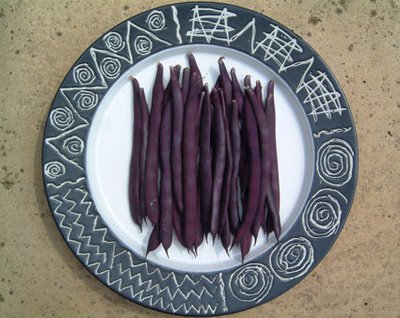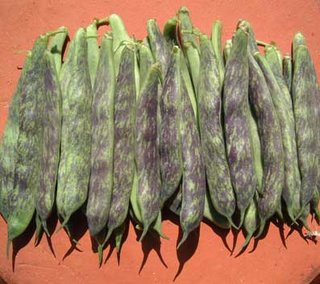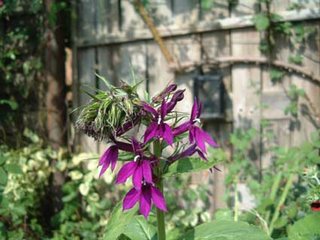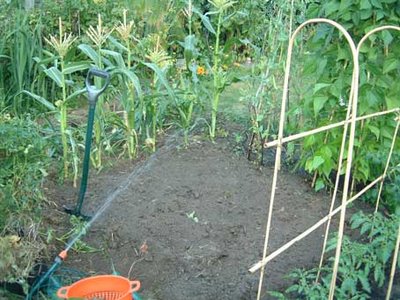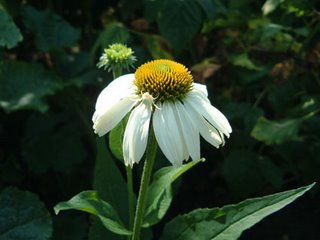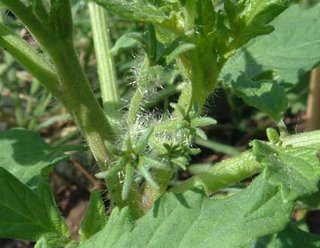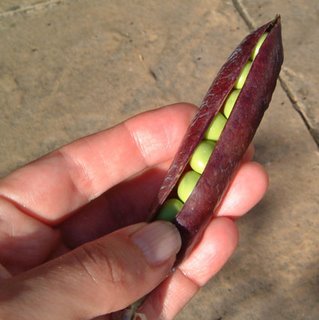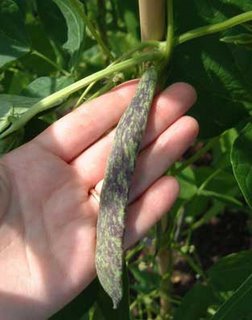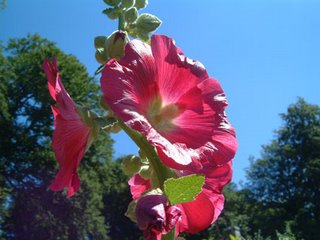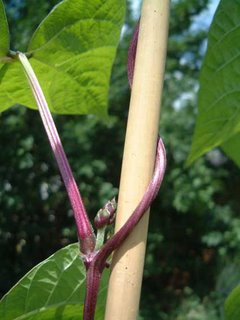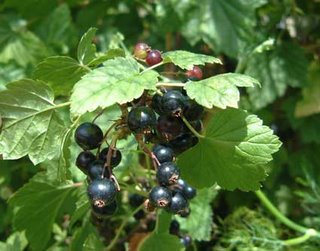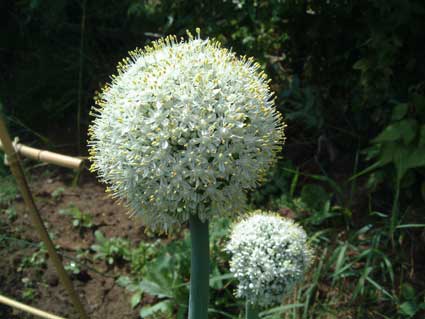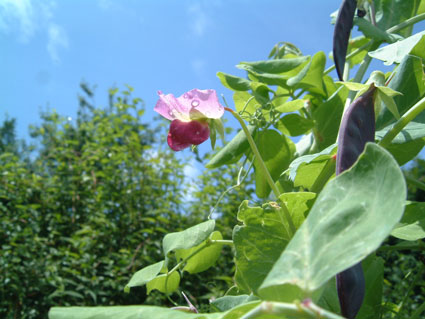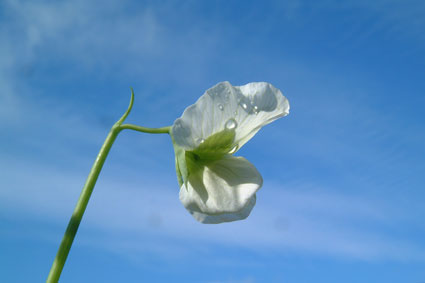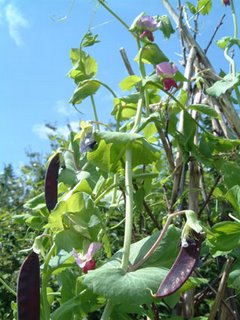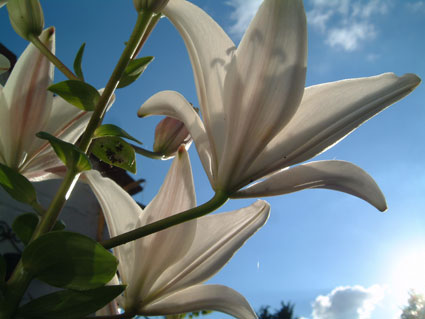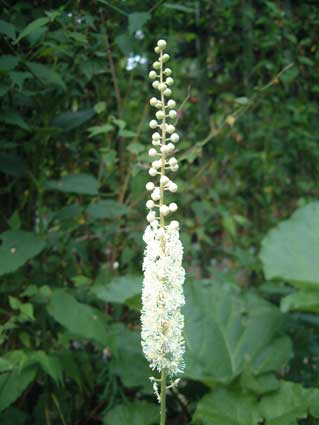 Edzell Blue is a Scottish beauty from the early 1900s. Its flavour is nice but not wildly exciting, and I still haven't found how to cook it to best advantage
Edzell Blue is a Scottish beauty from the early 1900s. Its flavour is nice but not wildly exciting, and I still haven't found how to cook it to best advantageI've been harvesting a lot of potatoes in the last few weeks, and I shouldn't need to buy any more from the supermarket for the rest of the year.
I love potatoes. They're my favourite food and I will eat them in any form (well, I might draw the line at raw) and I've always found them very rewarding to grow. They will stick their roots down through anything, even if you couldn't be bothered to dig it first, and will usually produce a decent crop even if they're completely neglected. I have some leggy-but-fine specimens growing under my shady compost shack, self-propagated from discarded tubers.
I was hoping to try some potato cross-breeding this year but I'm still trying to establish which of the varieties I have produces decent pollen. So far only
Marfona seems capable of setting top fruit, and unreliably at that. Potatoes are essentially inbreeders, but not to the same extent as tomatoes. It's easy to see why when you compare the flowers. Although ostensibly a similar shape, with the anthers fused together into a central cone, the potato flower has its stigmatic tip sticking out beyond the anther cone, where insects can jump around on it. Tomatoes usually have a shorter stigma; it stays inside the anther cone and gets self-pollinated whether it likes it or not.
But even with a sticky-outy stigma, potatoes don't readily cross-pollinate. Despite having bigger and prettier flowers than tomatoes they don't really attract anything. I often see butterflies and damsel flies on the
leaves of potatoes, but nothing seems to take much interest in its flowers.
The first potato I harvested this year, a few weeks ago, was
Maris Bard. It's a modern variety and a first early. Its flavour is absolutely wonderful. I only had one plant and its produce didn't hang around long enough to be photographed.
At the opposite end of the spectrum is
Fortyfold, 170 years old and very late maturing (mine hasn't even flowered yet). I harvested a few plants today though, because it's the only way I can get to my
Clementine tomatoes. As you may recall from an earlier post, I had to abandon a partially-constructed footpath in the veg garden when a community of slow worms moved in under the tarpaulin, and have only been able to reach stuff growing beyond the path by tramping across a double row of garlic and through the
Fortyfold spuds. Fed up with getting garlic scapes up my skirt and potato haulms caught round my ankles, I harvested a swath through both at the weekend to improve access.
 Fortyfold is the oldest known potato cultivar (introduced in 1836) and it's still pretty nice to look at
Fortyfold is the oldest known potato cultivar (introduced in 1836) and it's still pretty nice to look atThe mature tubers are mauve and cream, but some of the younger ones are a more intense purple. The colour doesn't survive any form of cooking though. They just turn bog-standard beige, although the streaking is still visible. The flavour is good, in an old-fashioned earthy kind of way, but they have tough skins and a lot of dry matter in them. My preferred use for them is roasting them in their skins and smothering them with gravy. But even then they take a bit of chewing. They are also nice baked ... the skins go thick and chewy with a flavour not unlike popcorn.
Red Duke of York is a variety that always does really well for me. It's the only potato I've ever grown which is largely untouched by slugs and wireworm. I had a few tubers that split in the dry weather, but otherwise they're trouble free. Yields are ridiculously high ... I dunno where to put them all.
 Red is my favourite colour, so you can imagine how much I like this variety, a reliable wartime spud introduced in 1942
Red is my favourite colour, so you can imagine how much I like this variety, a reliable wartime spud introduced in 1942The high yields are fortunate in the light of
Rebsie's First Law of Potato Harvesting, which states that whatever tool you use, and however far away from the plant you stick it in,
the first slice will always go through the biggest and best tuber. Harvesting
Red Duke of York today, I managed to slash open
two succulent potatoes
and a red ants' nest simultaneously in the first stroke! Wow.
My
Red Duke of York didn't flower at all this year, although it produced plenty of buds, but the plants are quite decorative anyway because they have a strong purple tinge in the leaves and stems. And the important thing is the lovely spuds. Harvested young they're a smooth red with freckles on. If left to mature for a bit they develop a crazed appearance (ha! I know the feeling) but they taste wonderful whenever you harvest them. Really, really good flavour ... sweet and refined. The flesh inside is yellowish.
The red pigment seems to act as a natural sunblock as well, because they don't go green when they're exposed to the sun unless they're left out for a very long time. The colour is retained to a greater or lesser extent after cooking. Boil it in its skin and it stays bright red. Bake it and it turns a golden russet.
Mr Little's Yetholm Gypsy is the novelty of novelties. But it's also a good 'un in its own right. I have yet to buy Alan Romans'
Potato Book (though I really really want it) but I understand he's the person responsible for preserving this unique variety, having been given a tuber by the late William Little of Yetholm (that's in the Scottish Borders, by the way, an appropriately magical area for the emergence of a strangely colourful vegetable). It's extraordinary in its colour, having both red and blue near the surface (in variable proportions) and a creamy-white inner flesh. Its origins are not known ... even Mr Little didn't seem to know where it had come from, having picked it up at a horse fair 50 years earlier.
 Mr Little's Yetholm Gypsy: Like a bit of colour interest in your spuds? Beat that!
Mr Little's Yetholm Gypsy: Like a bit of colour interest in your spuds? Beat that!Looking at it from the outside I wondered if it might share some ancestry with
Fortyfold, because I detect a certain similarity in the wispy streaks of colour in the skin. But it doesn't have the same texture or flavour.
One characteristic of this variety is that it's slow to chit (sprout). But that can be an advantage, because it extends the season. I planted four tubers in the spring and those plants are almost ready to harvest (I dug out a sneak preview for the photo above). Meanwhile, the rest of the tubers from the same original batch have been sitting on a north-facing windowsill since autumn last year and are still perfectly firm with healthy dark purple sprouts. They've only sprouted about half an inch in six months. I shall plant those whenever space in the garden allows. In a suburban garden within Cheltenham's gentle climate I can get away with planting potatoes ridiculously late, though I will have to hope for a blight-free summer ... many of these old varieties have poor resistance.
The plants are very lanky. I mean
very lanky. They grow bolt upright for a certain while and look very smart, and then they flop over and grow leggily in all directions. It isn't the tidiest of potatoes. But it does have quite pretty pale purple flowers, which if you're lucky will blossom before the rest of the foliage splats gracelessly over the floor.
 Dainty mauve flowers are a feature of Mr Little's Yetholm Gypsy
Dainty mauve flowers are a feature of Mr Little's Yetholm GypsyThe colouring in the tubers appears to be created by a thin layer of purple-blue pigment over a thin layer of pinky red pigment over white flesh. Some of the streaks appear naturally as the tuber grows. And when you wash the freshly dug spuds, a little of the dark blue rubs off and gives you more streaks of red and white. Then as the potato dries a little the colour seems to set and become permanent. It really is a most distinctive and unusual thing.
I was fully expecting the flavour to be insipid though. When you find something this wacky you can't really expect it to come up with a knock-out taste as well. But ... this is a very special potato. It tastes fantastic. Under its thickish skin the texture is waxy and moist, and the flavour strong, sweet and earthy. And as if that wasn't enough, it retains its colour after cooking! That's right, you can tuck into a blotchy purple red and white jacket potato and still be able to marvel at how magnificent it tastes.
Obtaining this exotic specimen may be difficult. I hope it will become commercially available in the coming years, because I'm sure lots of people would love to grow it. Mine came from
The Organic Gardening Catalogue (Chase Organics) in the form of laboratory-grown microplants. I've said before that I loathe microplants, and I'll say it again. I loathe microplants.
Yetholm Gypsy is one of several rare heritage varieties which can only be bought in microplant form at the moment. It costs ten quid for 5 tiny plants which have no immune system and succumb to every nastiness nature can throw at them. Then, if you manage to keep them alive for a whole season, you have to abstain from eating the tubers because you'll need to save them all as seed for the following year. These tubers you see in the picture above are the first edible ones I've had from plants I bought in the spring of 2005. I would much, much rather have bought them as seed potatoes if they'd been available.
Mr Little's Yetholm Gypsy has become my joint favourite potato along with the delectable
Marfona, which funnily enough is not a heritage variety, it's one which is often used for large-scale commercial crops.
Marfona was introduced from Holland in 1975 and is close to my idea of spud utopia. The main thing is the texture; a really waxy and moist melt-in-the-mouth texture but with enough substance to give you something to chew on. The flavour is really, really wonderful. Because of its rich moisture content it takes less time to cook than many spuds, is suitable for just about any purpose (though baking in its jacket is the most sublime experience) and generally needs less butter to give it a soft and buttery flavour. It's a truly superior variety and if I could only grow one spud, this would have to be it.
 Marfona may not look as exciting as some of the others, but the texture and flavour are out of this world
Marfona may not look as exciting as some of the others, but the texture and flavour are out of this worldLeft to grow to maturity it produces large baking-type potatoes, but you can harvest it more or less whenever you like. Yields are high. The plants are very large and vigorous with white flowers. Some of my crop has been blemished with scab on the surface but I'm not really bothered because it doesn't greatly affect the eating quality. Scab is very common in light and dry soil, and my garden soil is about as light and dry as it gets.
Still to come in the potato plot is
Witch Hill, another old and rare one bought (by necessity) as microplants and which I still haven't had the pleasure of tasting after 13 months of nurturing. It hasn't been doing hugely well in my garden, to be honest. Of the six tiny tubers I salvaged from last year's disastrous microplants, two plants have died. The other four were relentlessly attacked by slugs for weeks and weeks in the early summer. They are now looking reasonably healthy, so I'm hoping for a small crop ... eventually.
 Witch Hill ... a relic of the 1880s and currently proving a bugger to grow
Witch Hill ... a relic of the 1880s and currently proving a bugger to grow
 Golden Sweet peas: a saucerful of living history, with purple speckles
Golden Sweet peas: a saucerful of living history, with purple speckles
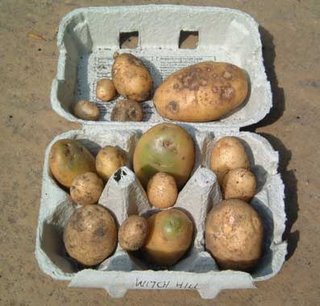 Pathetic results once again from the rare but much praised Witch Hill. Undamaged tubers salvagable for next year's seed are barely enough to fill an eggbox, leaving the scabby and mollusc-ravaged specimens in the top tray for me to eat as tasters. Yum.
Pathetic results once again from the rare but much praised Witch Hill. Undamaged tubers salvagable for next year's seed are barely enough to fill an eggbox, leaving the scabby and mollusc-ravaged specimens in the top tray for me to eat as tasters. Yum.





